Answered step by step
Verified Expert Solution
Question
1 Approved Answer
would like to ser the matlab code to solve this CHEN 2650-Lab 5: Simulations of Multi-component Systems Table of Cenients: I. Tit te Ivind domdioms


would like to ser the matlab code to solve this
CHEN 2650-Lab 5: Simulations of Multi-component Systems Table of Cenients: I. Tit te Ivind domdioms 1. 1 1 - Lab Cicioct mert 1.3-Code Criteks I 5 - Looking Ahead" i tis fleporl. 1. of fleport Fxpoctuftert 1.142 MATLAB Wive Seript 1 - Liquid-Liquid Extraction Consider a liquis fiquid etraction that is being cambed oul in a sepantory turnel This segaration uses seltetien parsioning of a solute between two immibeble phases, and it we bery a phase corttaining a solve into contact with a tecond phase, Fe solve partinoes isell between the two phases, as shown ty the disgram below: Schematic 1. A soparatory timnel with two sohonbs (Souree: Love touts) and a scheme tor a simplo liquidGevid extraction in which the sotute s parkioning depends only on a chomicai equiliorlum We can model the partioning of the solute between the two phases basod on a simple chemical equ litham. using the following differential equation: tdCis=kouingk0Cwp In these equations, Cxe and Cs are the concentrations of the solute in the organic and aqueous phases respoctively, while k0 is the rate of transloring trom the crganic phase to the aqueous phase and lwo is the reverse. Hore we will use the following finte diterence approximation to find an approvemate solution to the system of ODEs: y(n)=ty1yi 1.2LobObjectives 1.2.1-Derivatiane (itandwritien) dabowing tasks 1. Derive lnear dfference equations fin matro yormy that descrite the concentadion profies ch the solute in: the two phasen. 2 Transtorm your linear chalerance equations to eigurvalue/vecter form 1.2.2-Coding Eleasents 1. Compute the concontrations of the solute in the two phases atter the firmt 20 time steps usirig both math multiplication and eigenvaluervector focm and gonerato a piot to nompare - What fraction of the solute wil remain in each phase as time approaches infirity ciagge number al tim stepa)? Or tut another way. what is the extroction ealiciency? - Let's assume the eotraction is complote when the concenteations in the two phasef teaches gavs of equilibritum value. At what time is the extraction cornplete? 1.3 - Code Checks Generate a plot oomparing the concentrations of the solute in the two phases over time based based on eigervaluenector form and ode 45 . Represent the ode 45 solution as a solid line, while the inear aitterenci solution should be represented as points on the plot. Compare your handwritten derivation of the eigenvas vector lorm to those computed using the elg and 2 insolve functions. 1.4 - Lab Exploration Compute estimates for the extraction efliciency and extraction complete time based on the ode 45 simule How do they compare to those based on the finite difference approximation? Which do you expect (think? more accurate and why? 1.5 - Looking Ahead* This exercise is not required, Derive an analytical solution to the original system of ODEs. How do the compare to those based on the linear diflerence approximation? 1.6 - Report Expectations This Lab can be completed in small groups (4 or less people), and the names of all individuals that c the solution be clearly listed at the top of the submission (Each individual can be a member of onh) roupl). Everyone will be responsible for submitting a solution to the Lab, and all hand written eleme CHEN 2650-Lab 5: Simulations of Multi-component Systems Table of Cenients: I. Tit te Ivind domdioms 1. 1 1 - Lab Cicioct mert 1.3-Code Criteks I 5 - Looking Ahead" i tis fleporl. 1. of fleport Fxpoctuftert 1.142 MATLAB Wive Seript 1 - Liquid-Liquid Extraction Consider a liquis fiquid etraction that is being cambed oul in a sepantory turnel This segaration uses seltetien parsioning of a solute between two immibeble phases, and it we bery a phase corttaining a solve into contact with a tecond phase, Fe solve partinoes isell between the two phases, as shown ty the disgram below: Schematic 1. A soparatory timnel with two sohonbs (Souree: Love touts) and a scheme tor a simplo liquidGevid extraction in which the sotute s parkioning depends only on a chomicai equiliorlum We can model the partioning of the solute between the two phases basod on a simple chemical equ litham. using the following differential equation: tdCis=kouingk0Cwp In these equations, Cxe and Cs are the concentrations of the solute in the organic and aqueous phases respoctively, while k0 is the rate of transloring trom the crganic phase to the aqueous phase and lwo is the reverse. Hore we will use the following finte diterence approximation to find an approvemate solution to the system of ODEs: y(n)=ty1yi 1.2LobObjectives 1.2.1-Derivatiane (itandwritien) dabowing tasks 1. Derive lnear dfference equations fin matro yormy that descrite the concentadion profies ch the solute in: the two phasen. 2 Transtorm your linear chalerance equations to eigurvalue/vecter form 1.2.2-Coding Eleasents 1. Compute the concontrations of the solute in the two phases atter the firmt 20 time steps usirig both math multiplication and eigenvaluervector focm and gonerato a piot to nompare - What fraction of the solute wil remain in each phase as time approaches infirity ciagge number al tim stepa)? Or tut another way. what is the extroction ealiciency? - Let's assume the eotraction is complote when the concenteations in the two phasef teaches gavs of equilibritum value. At what time is the extraction cornplete? 1.3 - Code Checks Generate a plot oomparing the concentrations of the solute in the two phases over time based based on eigervaluenector form and ode 45 . Represent the ode 45 solution as a solid line, while the inear aitterenci solution should be represented as points on the plot. Compare your handwritten derivation of the eigenvas vector lorm to those computed using the elg and 2 insolve functions. 1.4 - Lab Exploration Compute estimates for the extraction efliciency and extraction complete time based on the ode 45 simule How do they compare to those based on the finite difference approximation? Which do you expect (think? more accurate and why? 1.5 - Looking Ahead* This exercise is not required, Derive an analytical solution to the original system of ODEs. How do the compare to those based on the linear diflerence approximation? 1.6 - Report Expectations This Lab can be completed in small groups (4 or less people), and the names of all individuals that c the solution be clearly listed at the top of the submission (Each individual can be a member of onh) roupl). Everyone will be responsible for submitting a solution to the Lab, and all hand written eleme Step by Step Solution
There are 3 Steps involved in it
Step: 1

Get Instant Access to Expert-Tailored Solutions
See step-by-step solutions with expert insights and AI powered tools for academic success
Step: 2

Step: 3

Ace Your Homework with AI
Get the answers you need in no time with our AI-driven, step-by-step assistance
Get Started


